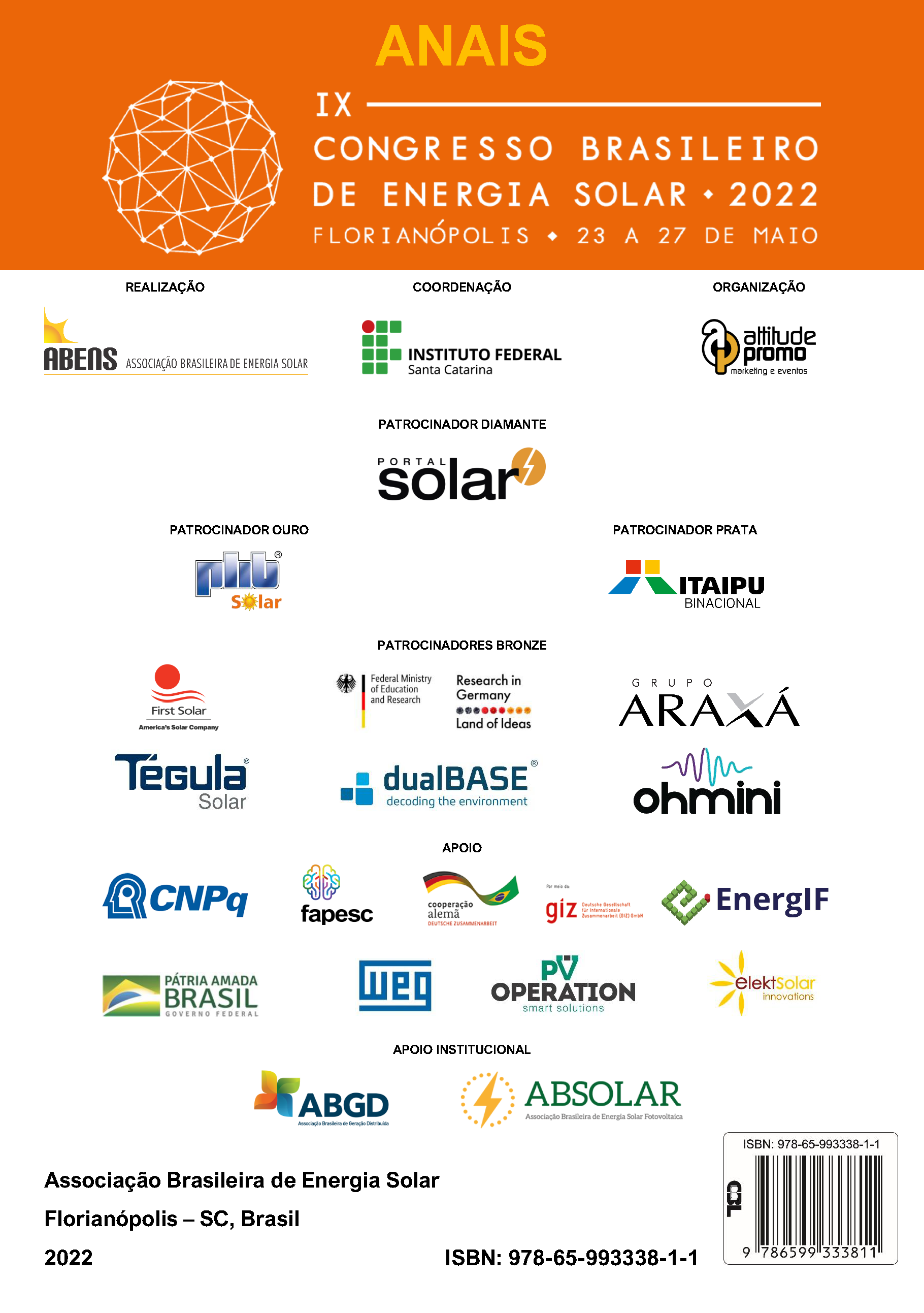VALUE CHAIN IN THE RECYCLING OF PHOTOVOLTAIC MODULES
DOI:
https://doi.org/10.59627/cbens.2022.1058Keywords:
Solar Energy, Recycling, Value ChainAbstract
With the increase of photovoltaics around the world, the global installed capacity is expected to reach 4,500GW in 2050. This market has grown significantly over the years and the volume of photovoltaic modules, a component used to convert solar energy into electrical energy, has also increased. Therefore, the increase in waste generated at the end of the useful life of these systems represents an environmental challenge for the application of new public policies, in addition to generating new opportunities with the reinsertion of these materials that can be recycled into a new value chain. The potential available for the photovoltaic waste market until 2030 represents about 8 tons of raw materials that can be inserted and used in the manufacturing of 60 million new modules, but only the European Union has specific regulations applied to photovoltaic waste. The different components can be used in new industries, such as the glass, metal, and even photovoltaic. With this great potential, there are challenges in countries that do not have specific public policies despite having great potential such as Brazil, which has great potential for implementing this kind of technology due to its privileged location. The country can use already consolidated public policies such as that of the EU, which carries out and proposes the control by manufacturers that supply in its territory over these deactivated and/or damaged IX Congresso Brasileiro de Energia Solar – Florianópolis, 23 a 27 de maio de 2022 modules. The success of a well-structured recycling system that will result in new value chains will depend on correct handling by the parties involved in the process, who must have their responsibilities as customers, suppliers and manufacturers defined and stipulated by current regulations.This study aims to present opportunities in the value chain of recycling photovoltaic modules, as well as demonstrate existing policies and perform a critical and comparative analysis.
Downloads
References
BALANÇO ENERGÉTICO NACIONAL. [S. l.: s. n,2020. Anual. Disponível em:
https://www.epe.gov.br/sitespt/publicacoes-dados-abertos/publicacoes/PublicacoesArquivos/publicacao-479/topico-528/BEN2020_sp.pdf . Acesso em: 23 jul. 2021.
BALANÇO ENERGÉTICO NACIONAL. [S. l.: s. n,2021. Anual. Disponível em: https://www.epe.gov.br/sitespt/publicacoes-dados-abertos/publicacoes/PublicacoesArquivos/publicacao-601/topico-596/BEN2021.pdf . Acesso em: 13 dez. 2021.
BAZIN, F.; BILLARD, Y.; LACROIX, O. Recycling of Photovoltaic Enf-of-Life Panels – International Overview. RECORD. Acesso em: 23 jul. 2021.
BRENNER, W.; ADAMOVIC, N.A Circular Economy for Photovoltaic Waste – the Vision of the European Project CABRISS.2017 40th International Convention on Information and Communication Technology, Electronics and Microelectronics (MIPRO), Opatija, 2017, pp. 146-151. DOI: 10.23919/MIPRO.2017.7973407. Disponível em: http://ieeexplore.ieee.org/stamp/stamp.jsp?tp=&arnumber=7973407&isnumber=7973 374
BROUWER, Karen Ann; GUPTA, Chaya; HONDA, Shelton. Methods and Concerns for Disposal of Photovoltaic Solar Panels. 2011. 77 f. Dissertação (Mestrado) - Science In Engineering, The Faculty Of The Department Of General Engineering, San Jose State University, San Jose, 2011. Disponível em:
http://citeseerx.ist.psu.edu/viewdoc/download?doi=10.1.1.456.5648&rep=rep1&type=pdf. Acesso em: 23 jul. 2021.
BNDES SETORIAL, B. BNDES Setorial, n. 40, set. 2014. , 2014
CRESESB CENTRO DE REFERÊNCIA PARA ENERGIA SOLAR E EÓLICA. Potencial Solar, 2020. DIRETIVA 2012/19/UE DO PARLAMENTO EUROPEU E DO CONSELHO, 2012. Disponível em: https://eurlex.europa.eu/legal-content/PT/TXT/PDF/?uri=CELEX:32012L0019&from=en . Acesso em 27 jul. 2021.
FRAIDENRAICH, N.; LYRA, F. Energia solar: fundamentos e tecnologias de conversão heliotérmica e fotovoltaica.: Ed universitária da UFPE. Recife, 1995.
FTHENAKIS, V. (2000), “End-of-Life Management and Recycling of PV Modules,” Energy Policy, Vol. 28, pp. 1051- 1058, Elsevier, Amsterdam. IEA-PVPS (2014), Review of Failures of Photovoltaic Modules, International Energy Agency - Photovoltaic Power Systems. Disponível em: www.iea-pvps.org. Acesso em 27 jul. 2021.
IRENA. END-OF-LIFE MANAGEMENT: Solar Photovoltaic Panels, 2016. Disponível em: https://www.irena.org/-/media/Files/IRENA/Agency/Publication/2016/IRENA_IEAPVPS_End-of-Life_Solar_PV_Panels_2016.pdf. Acesso em: 27 jul. 2021.
LATUNUSSA, C., ARDENTE, F., BLENGINI, G.A., MANCINI, L. Life Cycle Assessment of an Innovative Recycling Process for Crystalline Silicon Photovoltaic Panels. Solar Energy Materials & Solar Cells 156 (2016) 101–111.
OLIVEIRA, Daniel Rodrigues. Proposição de Abordagem para Avaliação de circularidade através de ferramentas de economia circular e da metodologia ACV: Estudo aplicado em um painel solar fotovoltaico de silício cristalino. 2019. Dissertação (Mestre em Engenharia de Produção) - Universidade Federal do Paraná, [S. l.], 2019. f. 156.
Disponível em: https://acervodigital.ufpr.br/bitstream/handle/1884/65739/R%20-%20D%20-%20DANIEL%20RODRIGUES%20DE%20OLIVEIRA.pdf?sequence=1&isAllowed=y. Acesso em: 6 jul. 2021.
PINHO, João Tavares; GALDINO, Marco Antonio. Manual de Engenharia para Sistemas Fotovoltaicos. Rio de Janeiro:
[s. n.], 2014. 530 p. Disponível em: http://www.cresesb.cepel.br/publicacoes/download/Manual_de_Engenharia
_FV_2014.pdf. Acesso em: 15 ago. 2021.
SINHA, P. and M. Cossette (2012), “End-of-Life CdTe PV Recycling with Semiconductor Refining,” 27th European 1 Photovoltaic Solar Energy Conference and Exhibition, Frankfurt am Main.
TOLMASQUIM, M. T. Energia Renovável - Hidráulica, Biomassa, Eólica, Solar, Oceânica. 2016.
VÉRONIQUE MONIER. European Commision. Study on Photovoltaic Panels Supplementing the Impact Assessment for a Recast of the WEEE Directive. Paris, 2011.


